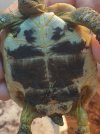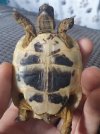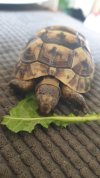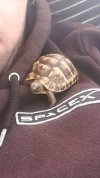CoreCollapse
New Member
Hello,
I was wondering if anybody could help me identify which subspecies of Greek I own?
I purchased these two at the beginning of the year with all the appropriate certificates provided, however it simply states 'T. Graeca' with no subspecies declared. When talking with the breeders (a local couple), they tolc me they weren't sure of the subspecies and had never bothered to think about it.
After doing some of my own research over the past couple of weeks, it seems the two most commonly kept Greeks here in the UK are Testudo Graeca Graeca and Testudo Graeca Nabeulensis.
Aftering finding that out, I attempted to find any more information on identification between the two species, but I didn't have much luck...
I believe they may be Nabeul Torts, but I'm not experienced enough to say with any certainty. My only reasons for this are they descriptions, of which these are closer to Nebeulensis than Graeca.
They have the light sandy blonde carapice with very dark 'splodges' on the middle of each scute, they have the yellowish facial 'mask' markings that Graeca seems to lack (going from photos for comparison) and their Plaston markings appear to resemble Nabeul more than Graeca in my opinion.
It would be amazing if someone with more experience could help me to narrow this down.
Thanks.
I was wondering if anybody could help me identify which subspecies of Greek I own?
I purchased these two at the beginning of the year with all the appropriate certificates provided, however it simply states 'T. Graeca' with no subspecies declared. When talking with the breeders (a local couple), they tolc me they weren't sure of the subspecies and had never bothered to think about it.
After doing some of my own research over the past couple of weeks, it seems the two most commonly kept Greeks here in the UK are Testudo Graeca Graeca and Testudo Graeca Nabeulensis.
Aftering finding that out, I attempted to find any more information on identification between the two species, but I didn't have much luck...
I believe they may be Nabeul Torts, but I'm not experienced enough to say with any certainty. My only reasons for this are they descriptions, of which these are closer to Nebeulensis than Graeca.
They have the light sandy blonde carapice with very dark 'splodges' on the middle of each scute, they have the yellowish facial 'mask' markings that Graeca seems to lack (going from photos for comparison) and their Plaston markings appear to resemble Nabeul more than Graeca in my opinion.
It would be amazing if someone with more experience could help me to narrow this down.
Thanks.






